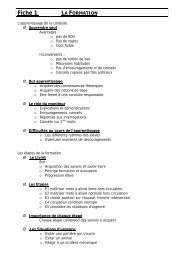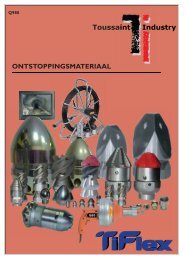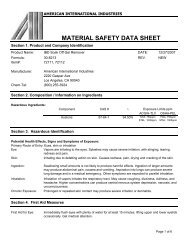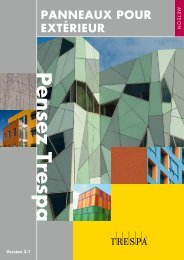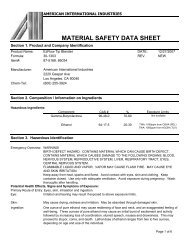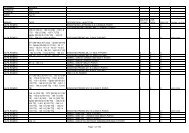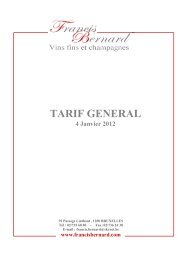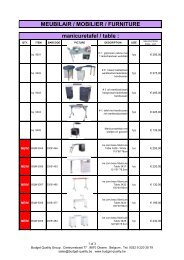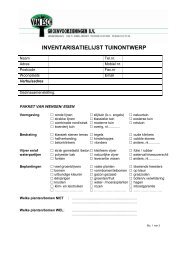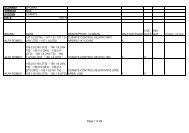PEAK PERFORMANCE - Proximedia
PEAK PERFORMANCE - Proximedia
PEAK PERFORMANCE - Proximedia
Create successful ePaper yourself
Turn your PDF publications into a flip-book with our unique Google optimized e-Paper software.
CARBOHYDRATE NUTRITION<br />
Carbohydrate drinks – can<br />
fructose enhance endurance?<br />
Despite the numerous claims to the contrary by<br />
the sports nutrition industry, real advances in<br />
sports nutrition are comparatively rare. But<br />
recent research into carbohydrate absorption<br />
and utilisation could herald a new breed of<br />
carbohydrate drink, which promises genuinely<br />
enhanced endurance performance. Andrew<br />
Hamilton explains<br />
Before we go on to discuss carbohydrate<br />
formulations, it’s worth recapping just why<br />
carbohydrate nutrition is so vital for athletes.<br />
Although the human body can use fat and<br />
carbohydrate as the principle fuels to provide<br />
energy, it’s carbohydrate that is the preferred or<br />
‘premium grade’ fuel for sporting activity.<br />
There are two main reasons for this. Firstly,<br />
carbohydrate is more oxygen-efficient than fat; each<br />
molecule of oxygen yields six molecules of ATP<br />
(adenosine triphosphate – the energy liberating<br />
molecule used in muscle contraction) compared<br />
with only 5.7 ATPs per oxygen molecule when fat is<br />
oxidised. That’s important because the amount of<br />
oxygen available to working muscles isn’t unlimited<br />
– it’s determined by your maximum oxygen uptake<br />
(VO 2max).<br />
Secondly and more importantly, unlike fat (and<br />
protein), carbohydrate can be broken down very<br />
rapidly without oxygen to provide large amounts of<br />
extra ATP via a process known as glycolysis during<br />
intense (anaerobic) exercise. And since all but<br />
<strong>PEAK</strong><br />
The research newsletter on<br />
<strong>PERFORMANCE</strong><br />
ultra-endurance athletes tend to work at or near<br />
their anaerobic threshold, this additional energy<br />
route provided by carbohydrate is vital for maximal<br />
performance. This explains why, when your muscle<br />
carbohydrate supplies (glycogen) run low, you<br />
sometimes feel as though you’ve hit a ‘wall’ and<br />
have to drop your pace significantly from that<br />
sustained when glycogen stores were higher.<br />
Carbohydrate storage<br />
Endurance training coupled with the right<br />
carbohydrate loading strategy can maximise<br />
glycogen concentrations, which can extend the<br />
duration of exercise by up to 20%before fatigue<br />
sets in (1) . Studies have shown that the onset of<br />
fatigue coincides closely with the depletion of<br />
glycogen in exercising muscles (2,3) .<br />
However, valuable as these glycogen stores are,<br />
and even though some extra carbohydrate (in the<br />
form of circulating blood glucose) can be made<br />
available to working muscles courtesy of glycogen<br />
stored in the liver, they are often insufficient to<br />
supply the energy needs during longer events.<br />
For example, a trained marathon runner can<br />
oxidise carbohydrate at around 200-250g per hour<br />
at racing pace; even if he or she begins the race<br />
with fully loaded stores, muscle glycogen stores<br />
would become depleted long before the end of the<br />
race. Premature depletion can be an even bigger<br />
problem in longer events such as triathlon or<br />
continued on page 2<br />
FREE SPORTS NUTRITION OFFER<br />
stamina, strength and fitness<br />
In this issue<br />
NUMBER 233<br />
1. Carbohydrate<br />
nutrition: why a<br />
glucose/fructose<br />
combination<br />
carbohydrate drink<br />
could help endurance<br />
performance<br />
5. Agility training:<br />
is dance training an<br />
efficient method of<br />
improving sporting<br />
agility, or are there<br />
better ways?<br />
8. Sport<br />
psychology: how to<br />
develop and enhance<br />
motivation for maximum<br />
performance<br />
11. What The<br />
Papers Say:<br />
● Injuries in<br />
synchronised skating<br />
● Comparison of<br />
antioxidants<br />
● Concussion and<br />
health risk in footballers<br />
Peak Performance is the world’s leading sport science newsletter. To<br />
receive our free weekly Sports Performance Bulletin and a free copy of<br />
the issue of PP this article appeared in (worth £5) simply go to<br />
http://www.pponline.co.uk/pphigh5.html
CARBOHYDRATE NUTRITION<br />
<strong>PEAK</strong> <strong>PERFORMANCE</strong> ISSUE 233<br />
2<br />
At a glance:<br />
● The importance of consuming carbohydrate during endurance events is explained;<br />
● The background to modern carbohydrate drink formulation is outlined;<br />
● Recent research on the potential benefits of mixed carbohydrate drinks containing<br />
fructose is presented;<br />
● Recommendations for endurance athletes are made.<br />
endurance cycling and can even be a problem for<br />
athletes whose events last 90 minutes or less and<br />
who have not been able to fully load glycogen<br />
stores beforehand.<br />
Given that stores of precious muscle glycogen<br />
are limited, can ingesting carbohydrate drinks<br />
during exercise help offset the effects of glycogen<br />
depletion by providing working muscles with<br />
another source of glucose? Back in the early 1980s,<br />
the prevailing consensus was that it made little<br />
positive contribution. This was because of the<br />
concern that carbohydrate drinks could impair<br />
fluid uptake, which might increase the risk of<br />
dehydration. It was also mistakenly believed that<br />
ingested carbohydrate in such drinks actually<br />
contributed little to energy production in the<br />
working muscles (4) .<br />
Later that decade, however, it became clear that<br />
carbohydrate ingested during exercise can indeed<br />
be oxidised at a rate of roughly 1g per minute (5-7)<br />
(supplying approximately 250kcals per hour) and<br />
a number of studies subsequently showed that this<br />
could be supplied and absorbed well by drinking<br />
600-1,200mls of a solution of 4-8% (40-80g per litre<br />
of water) carbohydrate solution per hour (8-11) . More<br />
importantly, it was also demonstrated both that<br />
this ingested carbohydrate becomes the<br />
predominant source of carbohydrate energy late<br />
in a bout of prolonged exercise (10) , and that it can<br />
delay the onset of fatigue during prolonged cycling<br />
and running as well as improving the power output<br />
that can be maintained (12,13) .<br />
Drink formulation<br />
The research findings above have helped to shape<br />
the formulation of most of today’s popular<br />
carbohydrate drinks. Most of these supply energy<br />
in the form of glucose or glucose polymers (see box<br />
right for explanation) at a concentration of around<br />
6%, to be consumed at the rate of around 1,000mls<br />
per hour, so that around 60g per hour of<br />
carbohydrate is ingested. Higher concentrations<br />
or volumes than this are not recommended<br />
because not only does gastric distress become a<br />
problem, but also the extra carbohydrate ingested<br />
is simply not absorbed or utilised.<br />
But as we’ve already mentioned, 60g per hour<br />
actually amounts to around 250kcals per hour, which<br />
provides only a modest replenishment of energy<br />
compared to that being expended during training or<br />
competition. Elite endurance athletes can burn over<br />
1,200kcals per hour, of which perhaps 1,000kcals or<br />
more will be derived from carbohydrate, leaving a<br />
Jargonbuster<br />
Glycolysis<br />
The partial but rapid<br />
breakdown of<br />
carbohydrate without<br />
oxygen<br />
Anaerobic threshold<br />
The exercise intensity at<br />
which the proportion of<br />
energy produced<br />
without oxygen rises<br />
significantly, resulting in<br />
an accumulation of<br />
lactate<br />
shortfall of at least 750kcals per hour. It’s hardly<br />
surprising, therefore, that one of the goals of sports<br />
nutrition has been to see whether it’s possible to<br />
increase the rate of carbohydrate replenishment.<br />
And now a series of studies carried out by scientists<br />
at the University of Birmingham in the UK indicates<br />
that this may indeed be possible.<br />
Carbohydrate type and performance<br />
Many of the early studies on carbohydrate feeding<br />
during exercise used solutions of glucose, which<br />
produced demonstrable improvements in<br />
performance as discussed. In the mid-1990s, some<br />
researchers experimented by varying the type of<br />
carbohydrate used in drinks, for example by using<br />
glucose polymers or sucrose (table sugar). However,<br />
it seemed that there was little evidence that these<br />
other types of carbohydrate offered any<br />
advantage (3) .<br />
But, at about the same time, a Canadian research<br />
team were experimenting with giving mixtures of<br />
two different sugars (glucose and fructose) to<br />
cyclists. In one experiment cyclists pedalled for two<br />
hours at 60% of VO 2max while ingesting 500mls of<br />
one of five different drink mixtures (14) :<br />
● 50g glucose;<br />
● 100g glucose;<br />
● 50g fructose;<br />
● 100g fructose;<br />
● 100g of 50g glucose + 50g fructose.<br />
CARBOHYDRATE BUILDING BLOCKS<br />
The fundamental building blocks of carbohydrates are molecules known as<br />
sugars. Although there are a number of sugars, the most important is<br />
glucose, which can be built into very long chains to form starch (found in<br />
bread, pasta, potatoes, rice etc). Fructose is also important, accounting for<br />
a significant proportion of the carbohydrate found in fruits. The<br />
disaccharide (ie two sugar unit) sucrose is composed of glucose and<br />
fructose linked together and is more commonly known as table sugar.<br />
Sports drinks often contain glucose and fructose, but also other<br />
carbohydrates such as dextrins, maltodextrins and glucose polymers. These<br />
consist of chains of glucose units linked together, with varying amounts of<br />
chain length and branching. Because of their more complex structure, more<br />
digestion is required, which tends to slow the rate of absorption, resulting in a<br />
smoother, more sustained uptake into the bloodstream.<br />
4<br />
6 CH2OH<br />
5<br />
3<br />
O O<br />
2<br />
1<br />
6 CH2OH<br />
β<br />
Fructose<br />
Glucose<br />
SUCROSE (TABLE SUGAR)<br />
= GLUCOSE + FRUSTOSE<br />
5<br />
4<br />
O<br />
HO<br />
3<br />
2<br />
OH<br />
HO OH<br />
GLUCOSE<br />
1 CH2OH<br />
O<br />
OH<br />
6CH2OH 6CH2OH 5 5<br />
4<br />
1 4<br />
2 O<br />
2<br />
3<br />
3<br />
O O<br />
α α<br />
Glucose Glucose<br />
MALTOSE (‘BREWERS SUGAR’)<br />
= GLUCOSE + GLUCOSE<br />
1
These sugars were radio-labelled with carbon-13<br />
so the researchers could see how well they were<br />
absorbed and oxidised for energy by measuring the<br />
amount of carbon dioxide containing carbon-13<br />
exhaled by the cyclists (as opposed to unlabelled<br />
carbon dioxide, which would indicate oxidation of<br />
stored carbohydrate). The key finding was that<br />
100g of the 50/50 glucose fructose mix produced a<br />
21% larger rate of oxidation than 100g of pure<br />
glucose alone and a 62% larger rate than 100g of<br />
pure fructose alone.<br />
Although these findings provided experimental<br />
support for using mixtures of carbohydrates in the<br />
energy supplements for endurance athletes, it<br />
wasn’t until 2003 that researchers from the<br />
University of Birmingham in the UK began<br />
looking more closely at the issue. In particular,<br />
they wanted to see whether combinations of<br />
different sugars could be absorbed and utilised<br />
more rapidly than the 1.0g per minute peak values<br />
that had been recorded with pure glucose drinks.<br />
One of their early experiments compared the<br />
oxidation rates of ingested carbohydrate in nine<br />
cyclists during three-hour cycling sessions at 60%<br />
of VO 2max (15) . During the rides, the cyclists drank<br />
1,950mls of radio-labelled carbohydrate solution,<br />
which supplied one of the following:<br />
● 1.8g per min of pure glucose;<br />
● 1.2g of glucose + 0.6g per minute of sucrose;<br />
● 1.2g of glucose + 0.6g per minute of maltose;<br />
● Water (control condition).<br />
The results showed that while the pure glucose and<br />
glucose/maltose drinks produced an oxidation rate<br />
of 1.06g of carbohydrate per minute, the<br />
glucose/sucrose combination drink produced a<br />
significantly higher rate of 1.25g per minute. This was<br />
an important finding because while both maltose<br />
and sucrose are disaccharides (see box opposite),<br />
maltose is composed of just two chemically bonded<br />
glucose molecules, whereas sucrose combines a<br />
glucose with a fructose molecule. This suggested that<br />
it was the glucose/fructose combination that was<br />
being absorbed more rapidly and therefore<br />
producing higher rates of carbohydrate oxidation.<br />
Fructose connection<br />
The same team had also performed another<br />
carbohydrate ingestion study on eight cyclists<br />
pedalling at 63% of VO 2max for two hours (16) . In<br />
this study the cyclists performed four exercise trials<br />
in random order while drinking a radio-labelled<br />
solution supplying of one of the following:<br />
● 1.2g per min of glucose (medium glucose);<br />
● 1.8g per min of glucose (high glucose);<br />
● 1.2g of glucose + 0.6g of fructose per minute<br />
(glucose/fructose blend);<br />
● Water (control).<br />
There were two key findings; firstly, the<br />
carbohydrate oxidation rate when drinking high<br />
glucose drink was no higher than when medium<br />
Intestinal absorption of glucose and fructose<br />
glucose was consumed; secondly, the peak and<br />
average oxidation rates of ingested glucose/fructose<br />
solution were around 50% higher than both of the<br />
glucose-only drinks.<br />
These findings point strongly to the fact that the<br />
maximum rate of glucose absorption into the body<br />
is around 1.2g per minute because feeding more<br />
produces no more glucose oxidation – probably<br />
because the absorption mechanism is already<br />
saturated. But because giving extra fructose does<br />
increase overall carbohydrate oxidation rates, they<br />
also indicate that fructose in the glucose/fructose<br />
drink was absorbed from the intestine via a different<br />
mechanism than glucose (see box above).<br />
The studies above and others (17) had shown that<br />
glucose/fructose mixtures do result in higher<br />
oxidation rates of ingested carbohydrate,<br />
especially in the later stages of exercise. But what<br />
the team wanted to find out was whether this extra<br />
carbohydrate uptake could help with water uptake<br />
from the intestine, and also whether the increased<br />
oxidation of ingested carbohydrate had a sparing<br />
effect on muscle glycogen, or other sources of<br />
stored carbohydrate (eg in the liver).<br />
To do this, they set up another study using a<br />
similar protocol to that above (eight trained cyclists<br />
pedalling at around 60% VO 2max on three separate<br />
occasions, ingesting one of three drinks on each<br />
occasion (18) ). However, in this study, the duration of<br />
the trial was extended to five hours during which the<br />
subjects drank one of the following:<br />
● 1.5g per minute of glucose;<br />
● 1.5g per minute of glucose/fructose mix (1.0g<br />
glucose/0.5g fructose);<br />
● Water (control).<br />
The water used in the drinks was also radio-labelled<br />
(to help determine uptake into the bloodstream)<br />
and the cycling trials were conducted in warm<br />
conditions (32 o C) to add heat stress. Exercise in the<br />
heat results in a greater reliance on carbohydrate<br />
metabolism, which is thought to be due to increased<br />
CARBOHYDRATE NUTRITION<br />
Like many nutrients, sugars aren’t absorbed passively – ie they don’t just ‘leak’<br />
across the intestinal wall into the bloodstream. They have to be actively<br />
transported across by special proteins called ‘transporter proteins’.<br />
We now know that the intestinal transport of glucose occurs via a glucose<br />
transporter called SGLT1, which is located in the brush-border membrane of<br />
the intestine. It is likely that the SGLT1-transporters become saturated at a<br />
glucose ingestion rate of around 1g per minute (ie all the transport sites are<br />
occupied), which means at ingestion rates above 1g per minute, the surplus<br />
glucose molecules have to ‘queue up’ to await transportation.<br />
In contrast to glucose, fructose is absorbed from the intestine by a completely<br />
different transporter called GLUT-5. So when carbohydrate is given at 1.8g per<br />
minute as 1.2g per min of glucose and 0.6g per min of fructose rather than 1.8g<br />
per min of pure glucose, the extra fructose molecules don’t have to ‘queue up’ as<br />
they have their own route across the intestine independent of glucose<br />
transporters. The net effect is that more carbohydrate in total finds its way into the<br />
bloodstream, which means that more is available for oxidation to produce energy.<br />
Jargonbuster<br />
Radio-labelled<br />
Where a normal atom<br />
in a compound (eg<br />
glucose) is replaced by<br />
a chemically identical<br />
atom, but one carrying<br />
a different number of<br />
neutrons (isotope)<br />
making it possible to<br />
track the fate of that<br />
compound using a<br />
technique known as<br />
spectrometry<br />
Carbon-13<br />
A carbon atom with an<br />
extra neutron in the<br />
nucleus<br />
Transporter proteins<br />
Large molecules that sit<br />
in cell walls and assist<br />
in the transport of<br />
substances in and out<br />
of the cell<br />
Brush-border<br />
membrane<br />
Densely packed<br />
protrusions (microvilli)<br />
on the intestinal wall,<br />
which help maximise<br />
nutrient absorption<br />
<strong>PEAK</strong> <strong>PERFORMANCE</strong> ISSUE 233<br />
3
CARBOHYDRATE NUTRITION<br />
<strong>PEAK</strong> <strong>PERFORMANCE</strong> ISSUE 233<br />
4<br />
muscle glycogen utilisation, and is associated with<br />
higher levels of fatiguing lactate concentrations.<br />
There were a number of important findings<br />
from this study:<br />
● During the last hour of exercise, the oxidation<br />
rate of ingested carbohydrate was 36% higher with<br />
glucose/fructose than with pure glucose (figure 1);<br />
● During the same time period, the oxidation rate<br />
of endogenous (ie stored) carbohydrate was<br />
significantly less with glucose/fructose than with<br />
pure glucose (figure 1);<br />
● The rate of water uptake from the gut into the<br />
bloodstream was significantly higher with<br />
glucose/fructose than with pure glucose (figure 2);<br />
● The perception of stomach fullness was reduced<br />
with the glucose/fructose drink compared to pure<br />
glucose;<br />
● Perceived rates of exertion in the later stages of<br />
the trial were lower with glucose/fructose than with<br />
pure glucose.<br />
Although no direct muscle glycogen measurements<br />
were made, the kinetics of the rate of appearance<br />
and disappearance of glucose in the bloodstream<br />
from the drinks led the researchers to postulate that<br />
the extra carbohydrate oxidation observed could be<br />
as a result of increased liver oxidation, or the<br />
formation of non-glucose energy substrates during<br />
exercise, such as lactate, which is known to be an<br />
important fuel for exercising muscles. More<br />
research is needed to determine the exact<br />
mechanisms involved.<br />
Implications for athletes<br />
These research findings are very encouraging;<br />
higher rates of energy production from ingested<br />
carbohydrate, lower rates from stored<br />
carbohydrate and increased water uptake sounds<br />
like a dream combination for endurance athletes.<br />
But can a glucose/fructose drink actually enhance<br />
endurance performance in real athletes under real<br />
race conditions?<br />
That’s the question scientists at the University<br />
of Hertfordshire are currently trying to answer in<br />
a double-blind, placebo controlled study to test<br />
commercially available drinks, which was set up<br />
earlier this year. The main goal is to compare the<br />
effects on cycling performance of a popular<br />
glucose/glucose polymer (containing very low<br />
levels of fructose – ~3-4%) drink with a 2:1<br />
glucose/fructose drink (trade name of ‘Super<br />
Carbs’ – 33% fructose) on cycling performance.<br />
The results of these trials are yet to be published,<br />
but according to the research team, the initial<br />
findings are ‘very promising’.<br />
References<br />
1. Sports Med 1997; 24:73-81<br />
2. Acta Physiol Scand 1967; 71:129-139<br />
3. Williams C, Harries M, Standish WD, Micheli LL<br />
(eds) (1998) Oxford Textbook of Sports Medicine,<br />
2nd edn. New York: Oxford University Press<br />
4. Int J Sports Med 1980; 1:2-14<br />
5. Sports Med 1992; 14: 27-42<br />
Figure 1: Drink type and fuel usage<br />
Relative contribution to<br />
total energy expenditure<br />
Relative contribution of fat, exogenous (ingested) and endogenous (stored)<br />
carbohydrate to energy expenditure during last hour of exercise<br />
Figure 2: Drink type and water uptake<br />
Relative water uptake<br />
125<br />
100<br />
75<br />
50<br />
25<br />
Recommendations for athletes<br />
If you’re an endurance athlete, is it worth rushing<br />
out and trying to get hold of a glucose/fructose<br />
drink to use during training/competition? Despite<br />
the promising initial research, the cautious<br />
approach would be to hold back until scientists<br />
have confirmed beyond doubt that these drinks<br />
really do confer a performance advantage.<br />
However, fructose is cheap, which means these<br />
drinks are no more expensive than conventional<br />
glucose/glucose polymer drinks; as all the<br />
indications are that any performance differences<br />
produced by a glucose/fructose drink will be<br />
positive, there’s certainly no harm in a ‘try it and<br />
see approach’, and possibly much to gain.<br />
Having said that, it’s important to remember<br />
that conventional glucose/glucose polymer drinks<br />
can still confer proven advantages for endurance<br />
athletes when taken during training or<br />
competition; both glucose/glucose polymer and<br />
glucose/fructose drinks can boost endurance<br />
performance over using nothing at all! But should<br />
the initial findings above be confirmed, the future<br />
for glucose/fructose carbohydrate drinks looks<br />
bright.<br />
6. Metabolism 1996; 45:915-921<br />
7. Am J Physiol Endocrinol Metab 1999; 276:<br />
E672-E683<br />
8. Med Sci Sports Ex 1993; 25:42-51<br />
9. Int J Sports Med 1994; 15:122-125<br />
10. Med Sci Sports Ex 1996; 28: i-vii<br />
11. J Athletic Training 2000; 35:212-214<br />
12. Int J Sports Nutr 1997; 7:26-38<br />
100% Fat<br />
75%<br />
50%<br />
25%<br />
0%<br />
0<br />
0 15 30<br />
WAT<br />
GLU GLU+FRUC<br />
45 60 75 90 105 120<br />
Time (min)<br />
Exogenous<br />
carbohydrate<br />
Endogenous<br />
carbohydrate<br />
Water<br />
Glucose<br />
+fructose<br />
Glucose<br />
Relative amount of<br />
water absorbed<br />
from the gut into<br />
the bloodstream<br />
during the last hour<br />
of exercise<br />
Andrew Hamilton BSc,<br />
MRSC, trained as a<br />
chemist and is now a<br />
consultant to the<br />
fitness industry and<br />
an experienced<br />
science writer<br />
13. Nutrition Reviews 1996; 54:S136-S139<br />
14. J Appl Physiol 1994; ss76(3):1014-9<br />
15. J Appl Physiol 2004; 96:1285-1291<br />
16. J Appl Physiol 2004; 96:1277-1284<br />
17. Med Sci Sports Exerc 2004; 36(9):1551-<br />
1558<br />
18. J Appl Physiol 2006; 100:807-816




